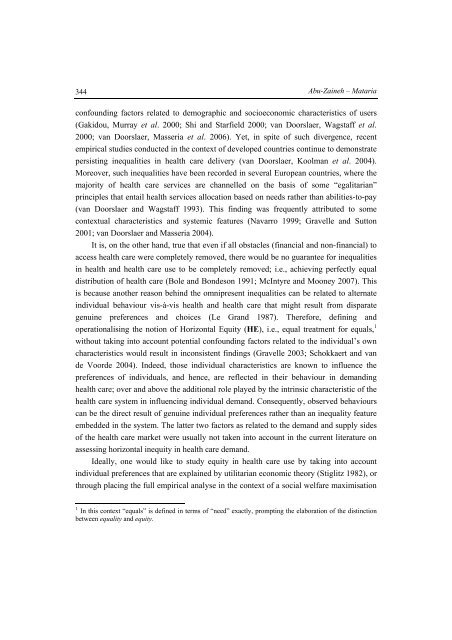The Palestinian Economy. Theoretical and Practical Challenges
The Palestinian Economy. Theoretical and Practical Challenges
The Palestinian Economy. Theoretical and Practical Challenges
Create successful ePaper yourself
Turn your PDF publications into a flip-book with our unique Google optimized e-Paper software.
344<br />
Abu-Zaineh – Mataria<br />
confounding factors related to demographic <strong>and</strong> socioeconomic characteristics of users<br />
(Gakidou, Murray et al. 2000; Shi <strong>and</strong> Starfield 2000; van Doorslaer, Wagstaff et al.<br />
2000; van Doorslaer, Masseria et al. 2006). Yet, in spite of such divergence, recent<br />
empirical studies conducted in the context of developed countries continue to demonstrate<br />
persisting inequalities in health care delivery (van Doorslaer, Koolman et al. 2004).<br />
Moreover, such inequalities have been recorded in several European countries, where the<br />
majority of health care services are channelled on the basis of some “egalitarian”<br />
principles that entail health services allocation based on needs rather than abilities-to-pay<br />
(van Doorslaer <strong>and</strong> Wagstaff 1993). This finding was frequently attributed to some<br />
contextual characteristics <strong>and</strong> systemic features (Navarro 1999; Gravelle <strong>and</strong> Sutton<br />
2001; van Doorslaer <strong>and</strong> Masseria 2004).<br />
It is, on the other h<strong>and</strong>, true that even if all obstacles (financial <strong>and</strong> non-financial) to<br />
access health care were completely removed, there would be no guarantee for inequalities<br />
in health <strong>and</strong> health care use to be completely removed; i.e., achieving perfectly equal<br />
distribution of health care (Bole <strong>and</strong> Bondeson 1991; McIntyre <strong>and</strong> Mooney 2007). This<br />
is because another reason behind the omnipresent inequalities can be related to alternate<br />
individual behaviour vis-à-vis health <strong>and</strong> health care that might result from disparate<br />
genuine preferences <strong>and</strong> choices (Le Gr<strong>and</strong> 1987). <strong>The</strong>refore, defining <strong>and</strong><br />
operationalising the notion of Horizontal Equity (HE), i.e., equal treatment for equals, 1<br />
without taking into account potential confounding factors related to the individual’s own<br />
characteristics would result in inconsistent findings (Gravelle 2003; Schokkaert <strong>and</strong> van<br />
de Voorde 2004). Indeed, those individual characteristics are known to influence the<br />
preferences of individuals, <strong>and</strong> hence, are reflected in their behaviour in dem<strong>and</strong>ing<br />
health care; over <strong>and</strong> above the additional role played by the intrinsic characteristic of the<br />
health care system in influencing individual dem<strong>and</strong>. Consequently, observed behaviours<br />
can be the direct result of genuine individual preferences rather than an inequality feature<br />
embedded in the system. <strong>The</strong> latter two factors as related to the dem<strong>and</strong> <strong>and</strong> supply sides<br />
of the health care market were usually not taken into account in the current literature on<br />
assessing horizontal inequity in health care dem<strong>and</strong>.<br />
Ideally, one would like to study equity in health care use by taking into account<br />
individual preferences that are explained by utilitarian economic theory (Stiglitz 1982), or<br />
through placing the full empirical analyse in the context of a social welfare maximisation<br />
1<br />
In this context “equals” is defined in terms of “need” exactly, prompting the elaboration of the distinction<br />
between equality <strong>and</strong> equity.
















